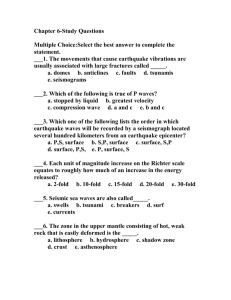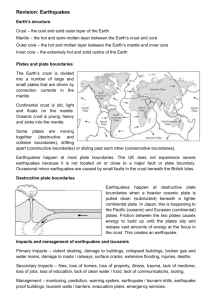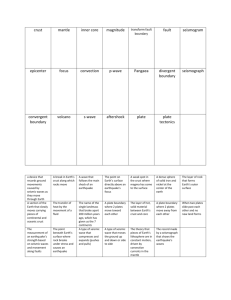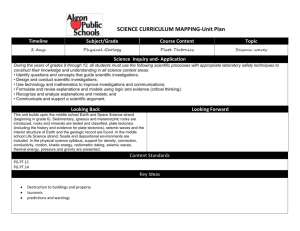8.1 What Is an Earthquake?
advertisement
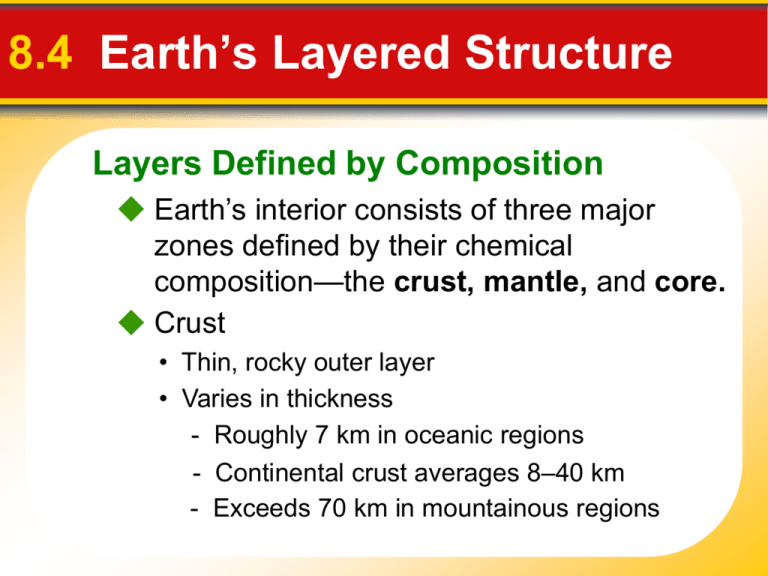
8.4 Earth’s Layered Structure Layers Defined by Composition Earth’s interior consists of three major zones defined by their chemical composition—the crust, mantle, and core. Crust • Thin, rocky outer layer • Varies in thickness - Roughly 7 km in oceanic regions - Continental crust averages 8–40 km - Exceeds 70 km in mountainous regions Seismic Waves Paths Through the Earth 8.4 Earth’s Layered Structure Layers Defined by Composition Crust • Continental crust - Upper crust composed of granitic rocks - Lower crust is more akin to basalt - Average density is about 2.7 g/cm3 - Up to 4 billion years old 8.4 Earth’s Layered Structure Layers Defined by Composition Crust • Oceanic crust - Basaltic composition - Density about 3.0 g/cm3 - Younger (180 million years or less) than the continental crust 8.4 Earth’s Layered Structure Layers Defined by Composition Mantle • Below crust to a depth of 2900 kilometers • Composition of the uppermost mantle is the igneous rock peridotite (changes at greater depths). 8.4 Earth’s Layered Structure Layers Defined by Composition Core • • • • Below mantle Sphere with a radius of 3486 kilometers Composed of an iron-nickel alloy Average density of nearly 11 g/cm3 8.4 Earth’s Layered Structure Layers Defined by Physical Properties Lithosphere • Crust and uppermost mantle (about 100 km thick) • Cool, rigid, solid Asthenosphere • • • • Beneath the lithosphere Upper mantle To a depth of about 660 kilometers Soft, weak layer that is easily deformed 8.4 Earth’s Layered Structure Layers Defined by Physical Properties Lower Mantle • 660–2900 km • More rigid layer • Rocks are very hot and capable of gradual flow. 8.4 Earth’s Layered Structure Layers Defined by Physical Properties Inner Core • Sphere with a radius of 1216 km • Behaves like a solid Outer Core • Liquid layer • 2270 km thick • Convective flow of metallic iron within generates Earth’s magnetic field Earth’s Layered Structure 8.4 Earth’s Layered Structure Discovering Earth’s Layers Moho ˇ´ • Velocity of seismic waves increases abruptly below 50 km of depth • Separates crust from underlying mantle Shadow Zone • Absence of P waves from about 105 degrees to 140 degrees around the globe from an earthquake • Can be explained if Earth contains a core composed of materials unlike the overlying mantle Earth’s Interior Showing P and S Wave Paths 8.4 Earth’s Layered Structure Discovering Earth’s Composition Crust • Early seismic data and drilling technology indicate that the continental crust is mostly made of lighter, granitic rocks. Mantle • Composition is more speculative. • Some of the lava that reaches Earth’s surface comes from asthenosphere within. 8.4 Earth’s Layered Structure Discovering Earth’s Composition Core • Earth’s core is thought to be mainly dense iron and nickel, similar to metallic meteorites. The surrounding mantle is believed to be composed of rocks similar to stony meteorites. 9.1 Continental Drift An Idea Before Its Time Wegener’s continental drift hypothesis stated that the continents had once been joined to form a single supercontinent. • Wegener proposed that the supercontinent, Pangaea, began to break apart 200 million years ago and form the present landmasses. Breakup of Pangaea 9.1 Continental Drift An Idea Before Its Time Evidence • The Continental Puzzle • Matching Fossils - Fossil evidence for continental drift includes several fossil organisms found on different landmasses. 9.1 Continental Drift An Idea Before Its Time Evidence • Rock Types and Structures - Rock evidence for continental exists in the form of several mountain belts that end at one coastline, only to reappear on a landmass across the ocean. • Ancient Climates Matching Mountain Ranges Glacier Evidence 9.1 Continental Drift Rejecting the Hypothesis A New Theory Emerges • Wegener could not provide an explanation of exactly what made the continents move. News technology lead to findings which then lead to a new theory called plate tectonics. 9.2 Plate Tectonics Earth’s Major Roles According to the plate tectonics theory, the uppermost mantle, along with the overlying crust, behaves as a strong, rigid layer. This layer is known as the lithosphere. • A plate is one of numerous rigid sections of the lithosphere that move as a unit over the material of the asthenosphere. 9.2 Plate Tectonics Types of Plate Boundaries Divergent boundaries (also called spreading centers) are the place where two plates move apart. Convergent boundaries form where two plates move together. Transform fault boundaries are margins where two plates grind past each other without the production or destruction of the lithosphere. Three Types of Plate Boundaries 9.3 Actions at Plate Boundaries Divergent Boundaries Oceanic Ridges and Seafloor Spreading • Oceanic ridges are continuous elevated zones on the floor of all major ocean basins. The rifts at the crest of ridges represent divergent plate boundaries. • Rift valleys are deep faulted structures found along the axes of divergent plate boundaries. They can develop on the seafloor or on land. • Seafloor spreading produces new oceanic lithosphere. Spreading Center 9.3 Actions at Plate Boundaries Divergent Boundaries Continental Rifts • When spreading centers develop within a continent, the landmass may split into two or more smaller segments, forming a rift. East African Rift Valley 9.3 Actions at Plate Boundaries Convergent Boundaries A subduction zone occurs when one oceanic plate is forced down into the mantle beneath a second plate. Oceanic-Continental • Denser oceanic slab sinks into the asthenosphere. • Pockets of magma develop and rise. • Continental volcanic arcs form in part by volcanic activity caused by the subduction of oceanic lithosphere beneath a continent. • Examples include the Andes, Cascades, and the Sierra Nevadas. Oceanic-Continental Convergent Boundary 9.3 Actions at Plate Boundaries Convergent Boundaries Oceanic-Oceanic • Two oceanic slabs converge and one descends beneath the other. • This kind of boundary often forms volcanoes on the ocean floor. • Volcanic island arcs form as volcanoes emerge from the sea. • Examples include the Aleutian, Mariana, and Tonga islands. Oceanic-Oceanic Convergent Boundary 9.3 Actions at Plate Boundaries Convergent Boundaries Continental-Continental • When subducting plates contain continental material, two continents collide. • This kind of boundary can produce new mountain ranges, such as the Himalayas. Continental-Continental Convergent Boundary Collision of India and Asia 9.3 Actions at Plate Boundaries Transform Fault Boundaries At a transform fault boundary, plates grind past each other without destroying the lithosphere. Transform faults • Most join two segments of a mid-ocean ridge. • At the time of formation, they roughly parallel the direction of plate movement. • They aid the movement of oceanic crustal material. Transform Fault Boundary 9.5 Mechanisms of Plate Motion Causes of Plate Motion Scientists generally agree that convection occurring in the mantle is the basic driving force for plate movement. • Convective flow is the motion of matter resulting from changes in temperature. 9.5 Mechanisms of Plate Motion Causes of Plate Motion Slab-Pull and Ridge-Push • Slab-pull is a mechanism that contributes to plate motion in which cool, dense oceanic crust sinks into the mantle and “pulls” the trailing lithosphere along. It is thought to be the primary downward arm of convective flow in the mantle. • Ridge-push causes oceanic lithosphere to slide down the sides of the oceanic ridge under the pull of gravity. It may contribute to plate motion. 9.5 Mechanisms of Plate Motion Causes of Plate Motion Mantle Convection • Mantle plumes are masses of hotter-thannormal mantle material that ascend toward the surface, where they may lead to igneous activity. • The unequal distribution of heat within Earth causes the thermal convection in the mantle that ultimately drives plate motion. Mantle Convection Models 8.1 What Is an Earthquake? Earthquakes An earthquake is the vibration of Earth produced by the rapid release of energy Focus and Epicenter • Focus is the point within Earth where the earthquake starts. • Epicenter is the location on the surface directly above the focus. Faults • Faults are fractures in Earth where movement has occurred. Focus, Epicenter, and Fault Slippage Along a Fault 8.1 What Is an Earthquake? Cause of Earthquakes Elastic Rebound Hypothesis • Most earthquakes are produced by the rapid release of elastic energy stored in rock that has been subjected to great forces. • When the strength of the rock is exceeded, it suddenly breaks, causing the vibrations of an earthquake. Elastic Rebound Hypothesis 8.1 What Is an Earthquake? Cause of Earthquakes Aftershocks and Foreshocks • An aftershock is a small earthquake that follows the main earthquake. • A foreshock is a small earthquake that often precedes a major earthquake. 8.2 Measuring Earthquakes Earthquake Waves Seismographs are instruments that record earthquake waves. Seismograms are traces of amplified, electronically recorded ground motion made by seismographs. Surface waves are seismic waves that travel along Earth’s outer layer. Seismograph Seismogram 8.2 Measuring Earthquakes Earthquake Waves Body Waves • Identified as P waves or S waves • P waves - Are push-pull waves that push (compress) and pull (expand) in the direction that the waves travel - Travel through solids, liquids, and gases - Have the greatest velocity of all earthquake waves 8.2 Measuring Earthquakes Earthquake Waves Body Waves • S waves - Seismic waves that travel along Earth’s outer layer - Shake particles at right angles to the direction that they travel - Travel only through solids - Slower velocity than P waves A seismogram shows all three types of seismic waves—surface waves, P waves, and S waves. Seismic Waves 8.2 Measuring Earthquakes Locating an Earthquake Earthquake Distance • The epicenter is located using the difference in the arrival times between P and S wave recordings, which are related to distance. Earthquake Direction • Travel-time graphs from three or more seismographs can be used to find the exact location of an earthquake epicenter. Earthquake Zones • About 95 percent of the major earthquakes occur in a few narrow zones. Locating an Earthquake 8.2 Measuring Earthquakes Measuring Earthquakes Historically, scientists have used two different types of measurements to describe the size of an earthquake —intensity and magnitude. Richter Scale • Based on the amplitude of the largest seismic wave • Each unit of Richter magnitude equates to roughly a 32-fold energy increase • Does not estimate adequately the size of very large earthquakes 8.2 Measuring Earthquakes Measuring Earthquakes Momentum Magnitude • Derived from the amount of displacement that occurs along the fault zone • Moment magnitude is the most widely used measurement for earthquakes because it is the only magnitude scale that estimates the energy released by earthquakes. • Measures very large earthquakes Earthquake Magnitudes Some Notable Earthquakes 8.3 Destruction from Earthquakes Seismic Vibrations The damage to buildings and other structures from earthquake waves depends on several factors. These factors include the intensity and duration of the vibrations, the nature of the material on which the structure is built, and the design of the structure. Earthquake Damage 8.3 Destruction from Earthquakes Seismic Vibrations Building Design • Factors that determine structural damage - Intensity of the earthquake - Unreinforced stone or brick buildings are the most serious safety threats - Nature of the material upon which the structure rests - The design of the structure 8.3 Destruction from Earthquakes Seismic Vibrations Liquefaction • Saturated material turns fluid • Underground objects may float to surface Effects of Subsidence Due to Liquefaction 8.3 Destruction from Earthquakes Tsunamis Cause of Tsunamis • A tsunami triggered by an earthquake occurs where a slab of the ocean floor is displaced vertically along a fault. • A tsunami also can occur when the vibration of a quake sets an underwater landslide into motion. • Tsunami is the Japanese word for “seismic sea wave.” Movement of a Tsunami 8.3 Destruction from Earthquakes Tsunamis Tsunami Warning System • Large earthquakes are reported to Hawaii from Pacific seismic stations. • Although tsunamis travel quickly, there is sufficient time to evacuate all but the area closest to the epicenter. 8.3 Destruction from Earthquakes Other Dangers Landslides • With many earthquakes, the greatest damage to structures is from landslides and ground subsidence, or the sinking of the ground triggered by vibrations. Fire • In the San Francisco earthquake of 1906, most of the destruction was caused by fires that started when gas and electrical lines were cut. Landslide Damage 8.3 Destruction from Earthquakes Predicting Earthquakes Short-Range Predictions • So far, methods for short-range predictions of earthquakes have not been successful. Long-Range Forecasts • Scientists don’t yet understand enough about how and where earthquakes will occur to make accurate long-term predictions. • A seismic gap is an area along a fault where there has not been any earthquake activity for a long period of time. 10.3 Plate Tectonics and Igneous Activity Convergent Plate Boundaries The basic connection between plate tectonics and volcanism is that plate motions provide the mechanisms by which mantle rocks melt to generate magma. Ocean-Ocean • Rising magma can form volcanic island arcs in an ocean (Aleutian Islands). Ocean-Continent • Rising magma can form continental volcanic arcs (Andes Mountains). Convergent Boundary Volcano 10.3 Plate Tectonics and Igneous Activity Divergent Plate Boundaries The greatest volume of volcanic rock is produced along the oceanic ridge system. • • • • Lithosphere pulls apart. Less pressure on underlying rocks Partial melting occurs Large quantities of fluid basaltic magma are produced. 10.3 Plate Tectonics and Igneous Activity Intraplate Igneous Activity Intraplate volcanism is igneous activity that occurs within a tectonic plate away from plate boundaries. • Most intraplate volcanism occurs where a mass of hotter than normal mantle material called a mantle plume rises toward the surface. • The activity forms localized volcanic regions called hot spots. • Examples include the Hawaiian Islands and the Columbia Plateau. Kilauea, an Intraplate Volcano 11.1 Rock Deformation Faults Normal Faults • Normal faults occur when the hanging wall block moves down relative to the footwall block. Reverse Faults and Thrust Faults • Reverse faults are faults in which the hanging wall block moves up relative to the footwall block. • Thrust faults are reverse faults with dips less than 45o. 11.1 Rock Deformation Folds Strike-Slip Fault • Strike-slip faults are faults in which the movement is horizontal and parallel to the trend, or strike, of the fault surface. Joints • Joints are fractures along which no appreciable movement has occurred. Four Types of Faults




